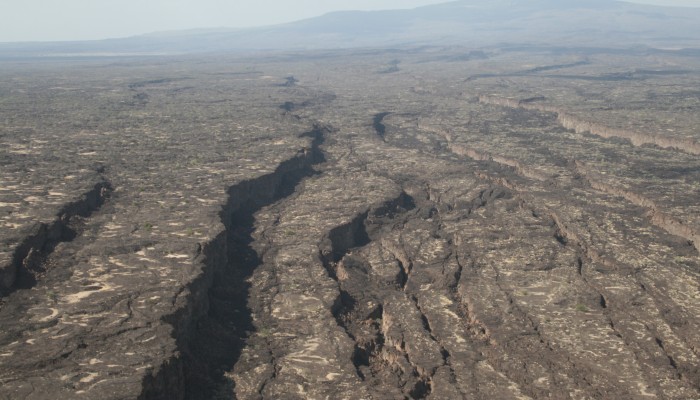
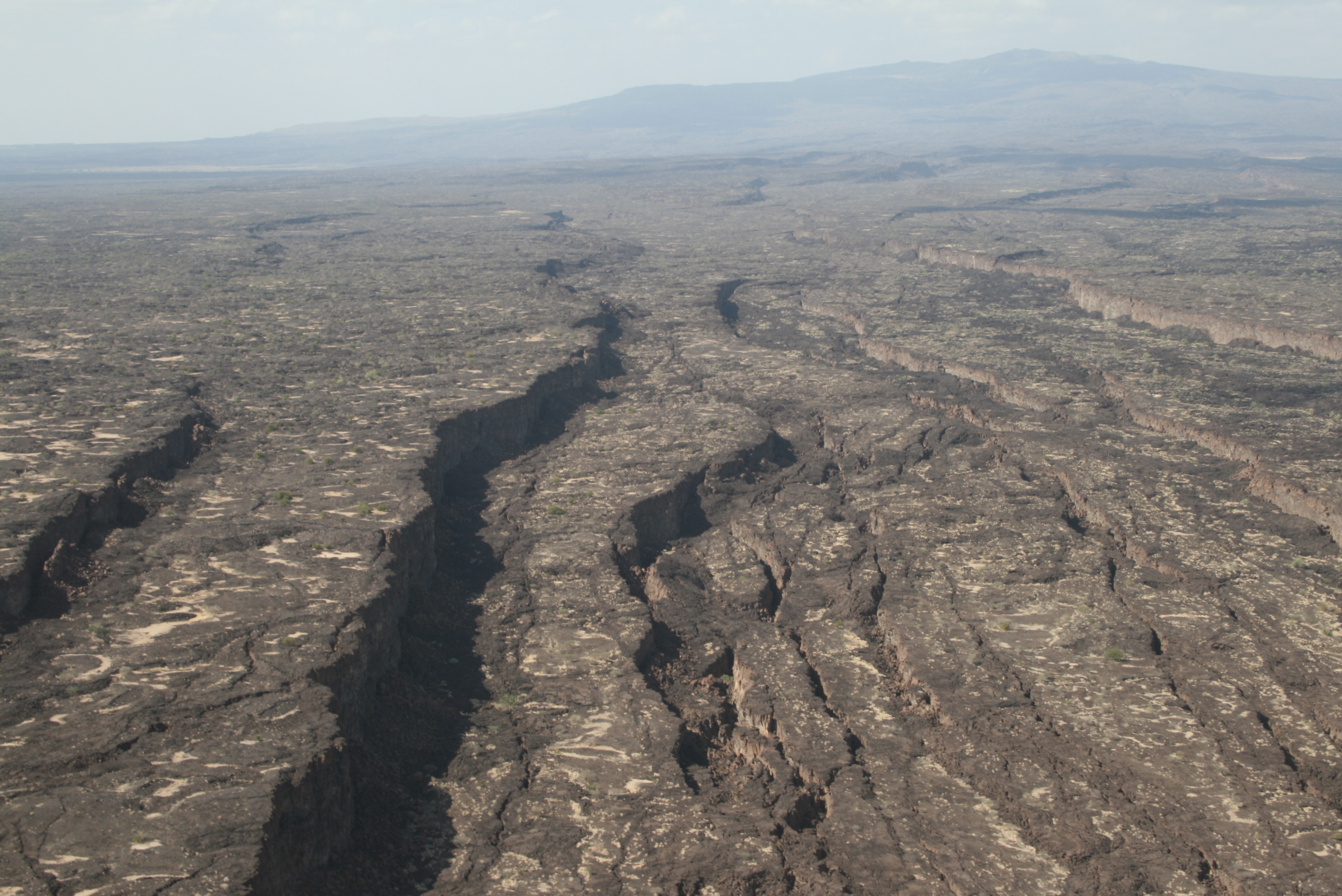
Aerial view, looking north along the Dabbahu-Manda-Hararo rift, Afar, Ethiopia. The stratovolcano, Dabbahu, lies in the background. Our new work shows that this rift is opening at about 20 mm/yr. Over the past 200,000 years, opening of this part of the rift has accounted for all of the motion between the Nubian and Arabian tectonic plates. The topography of this rift is thought to be similar to that of the mid-Atlantic ridge. Note the prominent fault scarps that cut through young basalt lava flows. The rift axis, and locus of current faulting and magmatism lies to the right hand side of the photo.
One piece of evidence that helped to establish the theory of Plate Tectonics in the early-1960’s was the recognition of patterns of magnetisation in the basalts of the seafloor that were symmetrical about the global oceanic ridge system. Fred Vine and Drummond Matthews recognised that this pattern had to be fixed in place as the lavas, that were erupted along the ocean ridge, cooled through a critical temperature (the Curie point). Below this point, they would become weakly magnetized, with a signature reflecting the local magnetic field. On long timescales (millions of years) Earth’s magnetic field changes in both intensity and direction, and it is the major changes in polarity, during which the field reverses, that lead to the striped ‘bar-code’ signature of magnetic stripes on the sea floor. In turn, the symmetrical pattern of this magnetic chart-recorder requires that most of these seafloor lavas are erupted in a narrow region at the oceanic ridge, which marks the point of separation between two tectonic plates. These observations led to the now well established theory that tectonic plates form at oceanic ridges, where magmas from the mantle below rise, and freeze to form the trailing edges of the separating plates.
While these processes are well understood for the sea-floor, we still don’t have a very good idea of what happens when a continental plate begins to split apart to form a new plate boundary. Think of the analogy of pulling apart a Mars bar. When you start to pull it from both ends, a number of fractures start to form in the brittle chocolate coating. But at what stage does the stretching become concentrated into the one major fracture, and what controls where that fracture forms? To get a closer understanding of how continents break up, there have been several concerted research efforts in the north-eastern parts of Africa (notably Ethiopia and Eritrea) over the past few decades. These have teased out the geological and geophysical events of the past 30 million years as the Ethiopian Rift Valley developed, and evolved to its current status, with a ‘triple junction’ forming at the boundaries of three plates (the Nubian Plate, beneath north Africa; and the Somalian and Arabian Plates).
A part of this evolving plate boundary now lies within the Afar region of Ethiopia. This is an area that is both remote and challenging to work in, but also a place that is geologically and culturally fascinating. It is the location, for example, of the oldest Hominid fossils known including Lucy (Australopithecus afarensis). With the sort of serendipity that geological fieldwork sometime relies upon, an opportunity to re-examine how a continent breaks up arose in late 2005, when a major segment of the plate boundary ruptured. In a series of events which are now very well documented (see references at the end), the Dabbahu-Manda-Hararo rift lurched into life. Over the next six years, the rift has experienced at least 14 further rifting events, three of which were associated with eruptions of basaltic magma. A multi-partner and multi-national research team has been working in the Afar since 2005, with the aim of using this active rifting episode to understand better how continents rift apart, and how new basaltic crust, which is typical of the ocean floor, begins to form.
One part of this effort was undertaken by David Ferguson for his PhD research at the University of Oxford. David collected many samples of basalt lava from a section that crossed from the present active rift, and out onto the older margins of the rift. This meant travelling on foot, 4×4 and helicopter, and the collection of many hundreds of kilogrammes of rock, which were then shipped back to the UK.
David then identified a small number of samples for dating, using the potassium (K) -argon (Ar) method. This method relies on the fact that all lavas contain small amounts of radioactive (and naturally occurring) K-40, which decays over time Ar-40. Since argon is a gas, is will naturally escape from lavas as they erupt; but once a lava is frozen, any Ar that subsequently forms by the decay of potassium will remain trapped within the finely-crystalline structure of the rock. By carefully breaking the rocks apart, pulling out the finely-crystalline fraction of the frozen melt and then heating the samples up in a controlled environment, David Ferguson and Andy Calvert, from the US Geological Survey, were able to extract and measure the tiny amounts of young Argon that had accumulated since eruption. Since we can measure the amount of potassium present in each rock; and since the rate of decay of potassium-40 is well known, these measurements tell us how much time that has passed since each lava sample erupted.
As we might expect, David found that the lava samples got progressively older the further away they were from the presently-active part of the rift. But interestingly, the lava samples all have the same chemical signatures as the present day lavas that have been erupted from the rift – suggesting that each of the dated lava flows were also erupted from the centre of the active rift at the time. This may all sound a little bit obvious, but the conclusions are actually quite interesting: they tell us that for the past 200,000 years most of the volcanic activity in this part of Afar has occurred in a narrow rift, as we see today. The older lavas now lie a few kilometres away from the active rift – and this tells us the rate at which the rift has been opening over this period of time. Here, we find that the spreading rate of the Dabbahu-Manda-Hararo rift is about 20 mm/year (or about 4 km in 200,000 years). This matches quite closely with the independent estimates of the rate at which the Nubian Plate is separating from the Arabian Plate. So in this location, we can be fairly sure that main fracture of the ‘Mars bar’ formed at least 200,000 years ago, and this has effectively become the place where the trailing edges of the two plates are forming and pulling apart. So here we have it – the seafloor-spreading process, and the formation of new basaltic crust, identified on land.
Reference: DJ Ferguson et al., 2013a, Constraining timescales of focussed magmatic accretion and extension in the Afar crust using lava geochronology, Nature Communications, 4, 1416.
Update. July 4, 2013.
David Ferguson has now published a new paper in Nature that brings together information both from petrology (the nature of the erupted lavas, and their chemical compositions) and from seismology to develop a self-consistent explanation of the deep structure of the rift. This new work shows that the compositions of geologically young lavas requires them to have formed relatively deep (greater than 80 km or so), and at relatively higher temperatures than expected for ‘normal’ mantle. This can only be reconciled with other geological and geophysical constraints if the plate beneath the active Afar rift is still relatively thick. This, in turn, is consistent with the idea that the slow rate of spreading at the rift means that plate remains thick because of conductive cooling, while volcanism persists because the mantle at depth is suffiiciently hot to partially melt at depths just a little deeper than the bottom of the plate. In turn, this fits in with ideas about the long-lasting and slowly waning influence of a ‘hot spot’ or plume beneath the region, which is the favoured contender for the burst of magmatism in the region about 30 million years ago.
Reference: DJ Ferguson et al., 2013b, Melting during late stage rifting in Afar is hot and deep, Nature 499, 70-73.
Further reading:
Ebinger, C. et al., 2010, Length and timescales of rift faulting and magma intrusion: the Afar Rifting Cycle from 2005 to present. Annual Reviews of Earth and Planetary Sciences 38, 439–466.
Wright, T. J. et al. 2006, Magma‐maintained rift segmentation at continental rupture in the 2005 Afar dyking episode. Nature 442, 291–294.
Acknowledgements: this work was funded by NERC as a part of the Afar Rift Consortium. It would not have been possible without the excellent support of our colleagues, collaborators and logistical support teams in Ethiopia and elsewhere. We are very grateful to the people of Digdigga for graciously permitting us to share their school buildings and to set up a field camp in their village, and to the people of Digdigga and Teru districts for allowing access to the region.


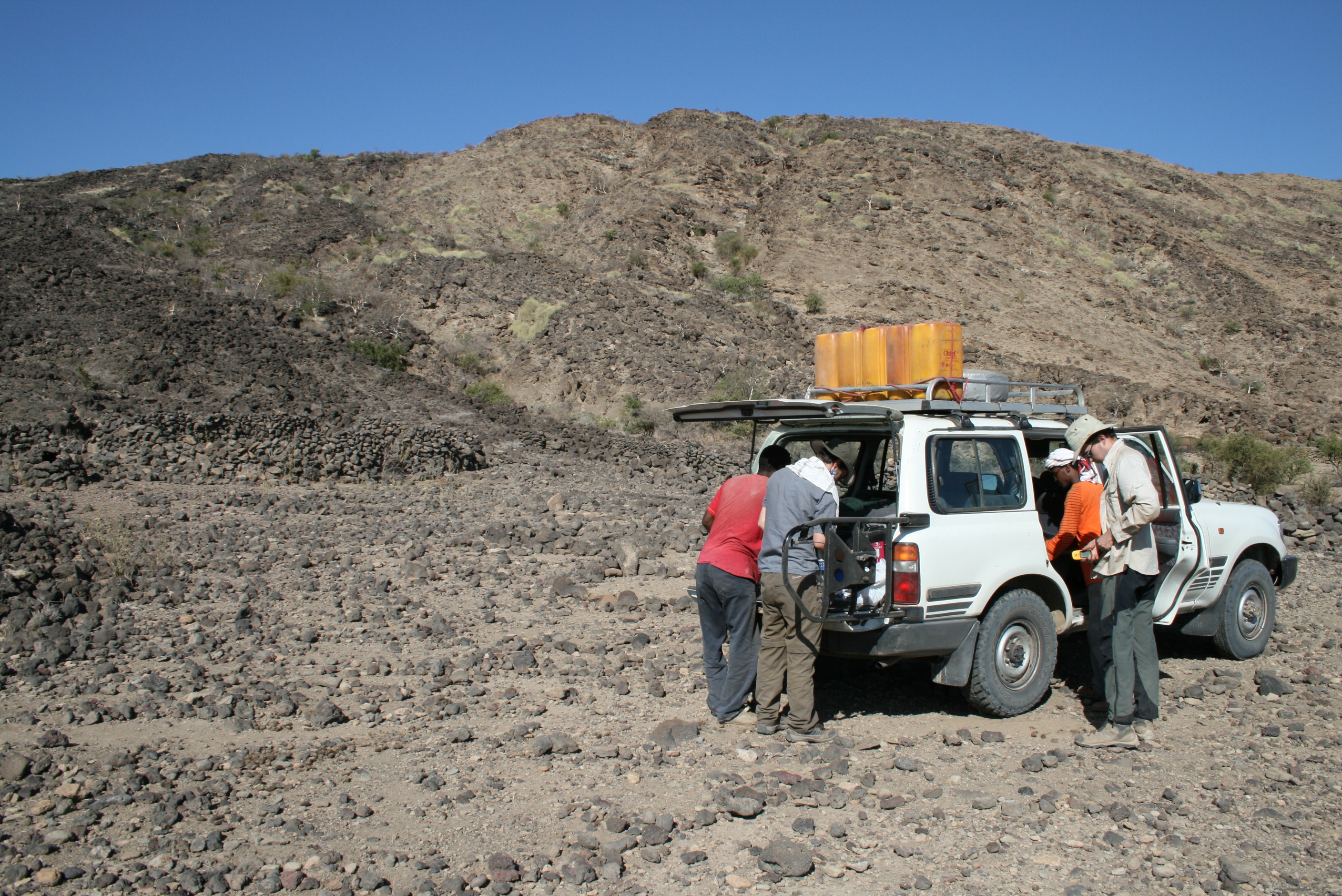

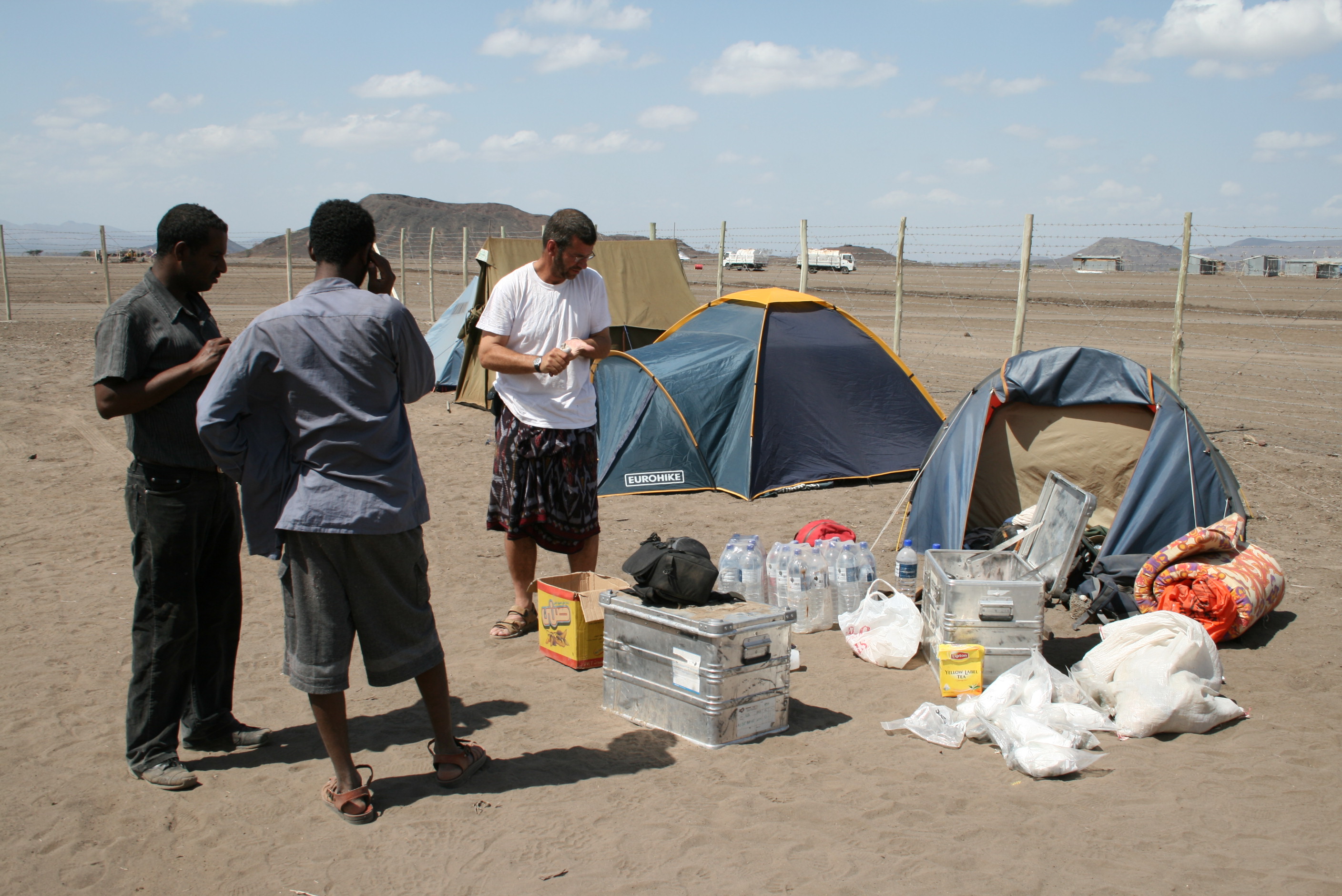
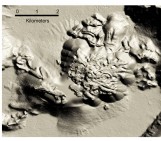
Pingback: Stuff we linked to on Twitter last week | Highly Allochthonous
Pingback: One year of volcanicdegassing | volcanicdegassing